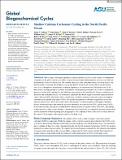Shallow calcium carbonate cycling in the North Pacific Ocean
Abstract
The cycling of biologically produced calcium carbonate (CaCO3) in the ocean is a fundamental component of the global carbon cycle. Here, we present experimental determinations of in situ coccolith and foraminiferal calcite dissolution rates. We combine these rates with solid phase fluxes, dissolved tracers, and historical data to constrain the alkalinity cycle in the shallow North Pacific Ocean. The in situ dissolution rates of coccolithophores demonstrate a nonlinear dependence on saturation state. Dissolution rates of all three major calcifying groups (coccoliths, foraminifera, and aragonitic pteropods) are too slow to explain the patterns of both CaCO3 sinking flux and alkalinity regeneration in the North Pacific. Using a combination of dissolved and solid-phase tracers, we document a significant dissolution signal in seawater supersaturated for calcite. Driving CaCO3 dissolution with a combination of ambient saturation state and oxygen consumption simultaneously explains solid-phase CaCO3 flux profiles and patterns of alkalinity regeneration across the entire N. Pacific basin. We do not need to invoke the presence of carbonate phases with higher solubilities. Instead, biomineralization and metabolic processes intimately associate the acid (CO2) and the base (CaCO3) in the same particles, driving the coupled shallow remineralization of organic carbon and CaCO3. The linkage of these processes likely occurs through a combination of dissolution due to zooplankton grazing and microbial aerobic respiration within degrading particle aggregates. The coupling of these cycles acts as a major filter on the export of both organic and inorganic carbon to the deep ocean.
Citation
Subhas , A V , Dong , S , Naviaux , J D , Rollins , N E , Ziveri , P , Gray , W , Rae , J W B , Liu , X , Byrne , R H , Chen , S , Moore , C , Martell-Bonet , L , Steiner , Z , Antler , G , Hu , H , Lunstrum , A , Hou , Y , Kemnitz , N , Stutsman , J , Pallacks , S , Dugenne , M , Quay , P D , Berelson , W M & Adkins , J F 2022 , ' Shallow calcium carbonate cycling in the North Pacific Ocean ' , Global Biogeochemical Cycles , vol. 36 , no. 5 , e2022GB007388 . https://doi.org/10.1029/2022GB007388
Publication
Global Biogeochemical Cycles
Status
Peer reviewed
ISSN
0886-6236Type
Journal article
Description
This work was funded by NSF OCE-1220301 to W.B., NSF OCE-1220600 to J.F.A., and startup funding for A.V.S.Collections
Items in the St Andrews Research Repository are protected by copyright, with all rights reserved, unless otherwise indicated.

